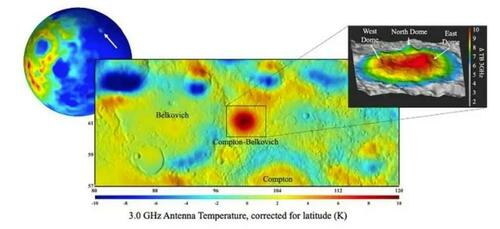In an unprecedented discovery, scientists have unearthed a colossal granite mass that has been gradually emitting heat, hidden beneath a lunar crater...
Authored by Elijah Cohen: In an unprecedented discovery, scientists have unearthed a colossal granite mass that has been gradually emitting heat, hidden beneath a lunar crater. This discovery is not a figment of science fiction, but a testament to the Moon’s volcanic past. While the Moon’s history of lava fields and eruptions is well-documented, the discovery of a more Earth-like volcano was a first, found beneath the Compton and Belkovich craters on the Moon’s far side.

The research team utilized data from both Chinese and American lunar orbiters to uncover this heat-emitting mass beneath the lunar surface, revealing a volcanic process previously unseen on the Moon.
“We used an instrument that observes microwave wavelengths, longer than infrared, sent to the Moon on both the Chinese Chang’E 1 and 2 orbiters. We found that one of these suspected volcanoes, known as Compton-Belkovich, was absolutely glowing at microwave wavelengths,” explained co-lead researcher Dr. Matt Siegler, of the Planetary Science Institute.
The data revealed a 20-kilometer-wide silicon-rich surface feature, believed to be the caldera of this ancient volcano.
The temperature in this area is 10°C warmer than its surroundings. However, this heat is not from magma beneath the surface, as the volcano’s last eruption was 3.5 billion years ago. Instead, the heat comes from radioactive elements trapped in the rocks.
“We interpret this heat flux as resulting from a radiogenic-rich granite body below the caldera,” Dr. Siegler said.
“We were a bit puzzled when we found it. Fortunately, my wife, Dr. Rita Economos, is the geochemist in the family, so with her guidance, we were able to piece together the probable geologic cause of the heat anomaly.”
Dr. Economos further explained, “This find is a 50km wide batholith; a batholith is a type of volcanic rock that forms when lava rises into the earth’s crust but does not erupt onto the surface. El Capitan and Half Dome, in Yosemite in California, are examples of similar granite rocks which have risen to the surface.”
The discovery of such a large granite deposit in an unexpected location suggests that there could be other areas of the Moon where granite can be found, and possibly in other parts of the Solar System as well.
The Moon’s volcanic activity is a fascinating topic that has intrigued scientists for decades. The Moon’s volcanic history extends back nearly 3 billion years, much longer than most planets in our solar system. The lunar volcanoes are not like the ones we have on Earth. They do not spew out a significant amount of lava, but instead, they release gases like radon and argon.
The Moon’s volcanic activity is believed to have played a crucial role in shaping its surface. The lunar maria, the dark plains seen on the Moon’s surface, are vast basaltic plains formed by ancient volcanic eruptions. These maria cover about 16% of the lunar surface, mainly on the near-side visible from Earth.
The discovery of the heat-emitting granite mass adds a new dimension to our understanding of the Moon’s volcanic activity. It provides a glimpse into the Moon’s dynamic past and opens up new avenues for exploring lunar geology. This discovery also raises the possibility of finding similar geological features on other celestial bodies, further expanding our knowledge of the universe.
The exploration of lunar volcanism also has implications for future lunar missions. Understanding the Moon’s geology can help in identifying suitable landing sites for spacecraft and potential resources for lunar bases. As we continue to explore the Moon and beyond, each discovery brings us one step closer to unraveling the mysteries of our solar system.

No comments:
Post a Comment